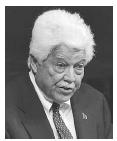MICRONESIA, FEDERATED STATES OF
Leo A. Falcam
President

(pronounced "LEE-oh fahl-KAHM")
" At the dawn of this new millennium, for the first time in all history, we proudly look beyond our borders to take our place in the world, and in this community of nations."
The Federated States of Micronesia (FSM) consists of 607 islands lying in a broad eastward sweep across 2.5 million sq km (965,250 sq mi) of the Western Pacific Ocean, between the equator and 14 degrees south latitude. These are part of an archipelago that originally appeared on European maps as the Caroline Islands. (Another Caroline Island group now constitutes the Republic of Palau.) Total land area is only 701.4 sq km (270.8 sq mi), with an additional 7,189 sq km (2,776 sq mi) of lagoons. About 65 of the islands are inhabited. Islands within the FSM are of two basic geologic types: large, mountainous islands of volcanic origin and small coral atolls. The high islands are beautifully endowed with forested mountains and reefs providing world-class diving sites. FSM is made up of four states: Pohnpei, Yap, Chuuk (formerly Truk), and Kosrae. The first three consist of several islands and islets; Kosrae, the smallest state, of just five closely situated islands.
The people of FSM are classified as Micronesian, with the exception of the inhabitants of Kapingamarangi and Nukuoro atolls in Pohnpei state, who are of Polynesian origin. Eight major indigenous languages are spoken in the nation, reflecting the cultural diversity of the people. English is the official language of government and is taught in the schools. In addition, many older people are familiar with Japanese as a result of the Japanese administrative era from 1914 through World War II. The total population was estimated at 135,869 in 2002. Almost half of these people lived in Chuuk state, a third in Pohnpei, a little over 10% in Yap, and less than 8% in Kosrae. As in many Pacific Island nations, FSM population is growing, averaging about 3% per year since the 1950s (though it was 1.8% in 2000). About 2% of the FSM population, however, leaves for the United States every year. There are growing communities of Micronesians in Hawaii and California. Overall the FSM population remains rural. Less than one-third are found in the urbanized areas.
Although FSM has a well-established money economy and a relatively high GNP compared to many Pacific Island nations, for some five decades the country has been a consumption economy funded by the United States. By 2001, the United States had invested nearly us$3 billion in FSM. Most of this money is not foreign aid as usually understood, but constitutes rental payments that provide the United States with exclusive access to the area's waterways for military use. Together with grants and other aid, total U.S. payments amount to about US $1,000 per capita annually. This money has not been used to create productive resources, but rather to expand the size and generosity of FSM's government. Beyond U.S. payments, fisheries dominate the domestic productive economy and offer great potential for expansion. The country has an Exclusive Economic Zone (EEZ) of 322 km (200 mi) rich in marine resources. Fishing by local people is mostly for subsistence; nearly all commercial fishing within the EEZ is conducted by foreign fleets who pay US $18-24 million annually in licensing fees. Observers have suggested that a fish processing plant could be built in Chuuk that would alleviate that state's high rate of unemployment and underemployment. The country's main agricultural crop, especially important in outer islands, is copra (dried coconut meat). Copra production has suffered from low prices in world markets, dropping from 8,500 tons in 1979 to a mere 200 in 1992, though some recovery has taken place more recently. Although FSM's rural population continues to provide for some of their basic needs through gardening and fishing, the significance of this subsistence sector to the overall economy is open to question. More than 23,000 tourists came to FSM in 1990, about 60% from the United States and 25% from Japan. Tourism suffers because of FSM's distance from mass markets, 4,023 km (2,500 mi) from Honolulu and 3,572 km (2,220 mi) from Tokyo. There is potential for eco-tourism as a revenue source if the presently inadequate stock of hotels and other accommodations can be expanded. The currency used in FSM is the U.S. dollar. The per capita gross national product (GNP) is US $2,000 (2001 estimate).
ADDRESS
Office of the President
PS53
Palikir Station, Pohnpei, FSM 96941
Comment about this article, ask questions, or add new information about this topic: